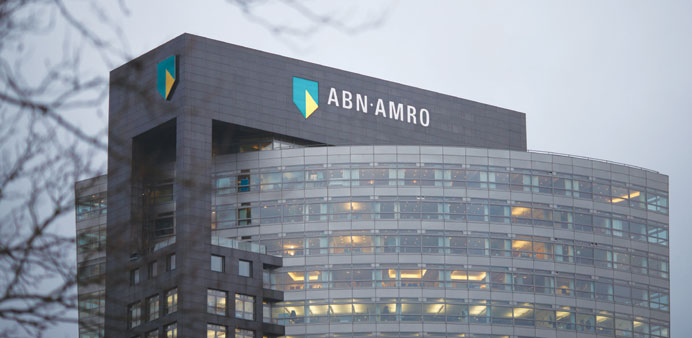The headquarters of ABN Amro Group in Amsterdam. The Dutch bank is returning to markets at a premium to European peers seven years after the Dutch government bailed out the bank.
Bloomberg
Amsterdam
ABN Amro Group is returning to markets at a premium to European peers seven years after the Dutch government bailed out the bank.
The government is selling a 23% stake in the nationalised lender at between €16 and €20 a share, the company said in an e-mailed statement yesterday. At the high end, that would value the bank at more than €18.8bn.
ABN Amro’s tangible book value at the end of September was €15.8bn, according to spokesman Jeroen van Maarschalkerweerd. This indicates ABN Amro may start trading at about 1.2 times book value compared with an average book value of 1.1 for the 46-member firms tracked by STOXX Europe 600 Banks Index.
“The valuation is looking solid,” said Jos Versteeg, an analyst at Theodoor Gilissen Bankiers NV. “Whichever premium the government and ABN Amro may get after all these years will depend on the market climate in the end.”
Concerns about China’s growth outlook rocked markets during the summer, creating more difficult markets for public offerings. French asset manager Amundi yesterday narrowed its IPO price range to the lower end.
The state, which spent €22bn to bail out the bank following the 2008 financial crisis, is seeking to recoup as much as €4.3bn ($4.6bn) in the first of a series of stake sales. The shares are set to begin trading in Amsterdam on November 20 under the symbol ABN.
“We’re going to sell it as good as possible with the best possible proceeds,” Finance Minister Jeroen Dijsselbloem told reporters in Brussels yesterday. “In the next couple of years we will be busy selling tranches.”
The offering is shaping up as Europe’s largest banking IPO since Russia’s VTB Bank raised €6bn more than eight years ago. Spanish lenders CaixaBank and Bankia raised €3.9bn and €3.1bn respectively in September 2007 and April 2011.
ABN Amro is a remnant of the former ABN Amro Holding, one of the world’s largest banks when it fell prey in 2007 to a group including Royal Bank of Scotland, Banco Santander and Fortis.
The €72bn takeover, the industry’s largest-ever, proved disastrous for RBS and Fortis when the financial crisis struck a year later.
The UK government bailed out RBS, while the Netherlands seized the Dutch banking and insurance units of Fortis and enlisted Gerrit Zalm, a former finance minister, to rebuild ABN Amro into a smaller bank focused on its home market.
“Obtaining a listing is a logical step following the strides we have made in our development since the establishment of ABN Amro in its current form in 2010,” the chief executive officer said in the statement Tuesday. “Our business case is solid, we have a moderate risk profile and are able to offer our clients a broad range of services.”
The second quarter was the most profitable three months for the bank since it was reinvented in 2010. ABN Amro said in September that it plans to pay out 50% of profit in dividends in 2017, up from 40% this year.
ABN Amro Monday reported a 13% rise in third-quarter profit on lower write-downs of bad loans. Underlying net income, which strips out one-time items, rose to €509mn from €450mn a year earlier.
The government held off a decision on the size and timing of the IPO earlier this year after the bank came under fire for giving each of six board members a €100,000 raise. Dijsselbloem said in May that the government would go ahead with the IPO as soon as this year and that it may sell as much as 30% of its stake.
“ABN has gone quite conservative. They have to make it a success,” said Corne van Zeijl, who manages 1bn euros on behalf of Actiam. “The low percentage of shares on offer is clearly at the bottom end of expectations.”
At least 10% of ABN Amro shares will go to retail investors, who’ll receive a preferential treatment when subscribing to the offering, according to a letter Dijsselbloem sent to the Dutch parliament.



